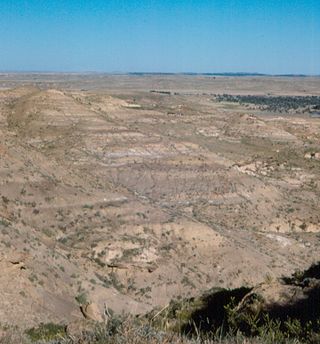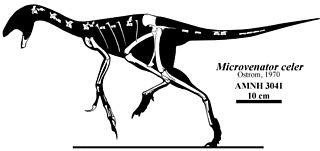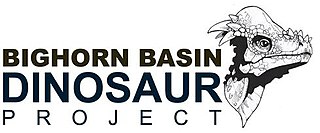Related Research Articles
Neoliotomus is a genus of North American mammal from the Paleocene. It existed in the age immediately following the extinction of the last dinosaurs and was a member of the extinct order Multituberculata. It lies within the suborder Cimolodonta and the superfamily Ptilodontoidea. Other than that, its affinities are somewhat unclear.

The Morrison Formation is a distinctive sequence of Upper Jurassic sedimentary rock found in the western United States which has been the most fertile source of dinosaur fossils in North America. It is composed of mudstone, sandstone, siltstone, and limestone and is light gray, greenish gray, or red. Most of the fossils occur in the green siltstone beds and lower sandstones, relics of the rivers and floodplains of the Jurassic period.

John Harold Ostrom was an American paleontologist who revolutionized the modern understanding of dinosaurs. Ostrom's work inspired what his pupil Robert T. Bakker has termed a "dinosaur renaissance".

Charles Hazelius Sternberg was an American fossil collector and paleontologist. He was active in both fields from 1876 to 1928, and collected fossils for Edward Drinker Cope and Othniel C. Marsh, and for the British Museum, the San Diego Natural History Museum and other museums.

Barnum Brown, commonly referred to as Mr. Bones, was an American paleontologist. He discovered the first documented remains of Tyrannosaurus during a career that made him one of the most famous fossil hunters working from the late Victorian era into the early 20th century.

Auroraceratops, meaning "dawn horned face", is a genus of bipedal basal neoceratopsian dinosaur, from the Early Cretaceous of north central China. The etymology of the generic name refers to its status as an early ceratopsian and also to Dawn Dodson, wife of Peter Dodson, one of the palaeontologists who described it.

The Lance (Creek) Formation is a division of Late Cretaceous rocks in the western United States. Named after Lance Creek, Wyoming, the microvertebrate fossils and dinosaurs represent important components of the latest Mesozoic vertebrate faunas. The Lance Formation is Late Maastrichtian in age, and shares much fauna with the Hell Creek Formation of Montana and North Dakota, the Frenchman Formation of southwest Saskatchewan, and the lower part of the Scollard Formation of Alberta.

Microvenator is a genus of dinosaur from the Early Cretaceous Cloverly Formation in what is now south central Montana. Microvenator was an oviraptorosaurian theropod. The holotype fossil is an incomplete skeleton, most likely a juvenile with a length of 1.3 m (4.3 ft), and consequently, the adult size remains uncertain. Microvenator celer is primitive and may be the "sister taxon to all other oviraptorosaurs."

The Wyoming Dinosaur Center is located in Thermopolis, Wyoming and is one of the few dinosaur museums in the world to have excavation sites within driving distance. The museum displays the Thermopolis Specimen of Archaeopteryx, which is one of only two real specimens of this genus on display outside of Europe.

Charles Whitney Gilmore was an American paleontologist who gained renown in the early 20th century for his work on vertebrate fossils during his career at the United States National Museum. Gilmore named many dinosaurs in North America and Mongolia, including the Cretaceous sauropod Alamosaurus, Alectrosaurus, Archaeornithomimus, Bactrosaurus, Brachyceratops, Chirostenotes, Mongolosaurus, Parrosaurus, Pinacosaurus, Styracosaurus ovatus and Thescelosaurus.

Walter Willis Granger was an American vertebrate paleontologist who participated in important fossil explorations in the United States, Egypt, China and Mongolia.

The Cloverly Formation is a geological formation of Early and Late Cretaceous age that is present in parts of Montana, Wyoming, Colorado and Utah in the western United States. It was named for a post office on the eastern side of the Bighorn Basin in Wyoming by N.H. Darton in 1904. The sedimentary rocks of formation were deposited in floodplain environments and contain vertebrate fossils, including a diverse assemblage of dinosaur remains. In 1973, the Cloverly Formation Site was designated as a National Natural Landmark by the National Park Service.

The Paleozoological Museum of China is a museum in Beijing, China. The same building also houses the Institute of Vertebrate Paleontology and Paleoanthropology of the Chinese Academy of Sciences. The museum contains exhibition halls with specimens aimed at the public, while the rest of the building is used for research purposes.

Paleontology in Wyoming includes research into the prehistoric life of the U.S. state of Wyoming as well as investigations conducted by Wyomingite researchers and institutions into ancient life occurring elsewhere.

Paleontology in Utah refers to paleontological research occurring within or conducted by people from the U.S. state of Utah. Utah has a rich fossil record spanning almost all of the geologic column. During the Precambrian, the area of northeastern Utah now occupied by the Uinta Mountains was a shallow sea which was home to simple microorganisms. During the early Paleozoic Utah was still largely covered in seawater. The state's Paleozoic seas would come to be home to creatures like brachiopods, fishes, and trilobites. During the Permian the state came to resemble the Sahara desert and was home to amphibians, early relatives of mammals, and reptiles. During the Triassic about half of the state was covered by a sea home to creatures like the cephalopod Meekoceras, while dinosaurs whose footprints would later fossilize roamed the forests on land. Sand dunes returned during the Early Jurassic. During the Cretaceous the state was covered by the sea for the last time. The sea gave way to a complex of lakes during the Cenozoic era. Later, these lakes dissipated and the state was home to short-faced bears, bison, musk oxen, saber teeth, and giant ground sloths. Local Native Americans devised myths to explain fossils. Formally trained scientists have been aware of local fossils since at least the late 19th century. Major local finds include the bonebeds of Dinosaur National Monument. The Jurassic dinosaur Allosaurus fragilis is the Utah state fossil.

Paleontology in the United States can first be traced to the Native Americans, who have been familiar with fossils for thousands of years. They both told myths about them and applied them to practical purposes. African slaves also contributed their knowledge; the first reasonably accurate recorded identification of vertebrate fossils in the new world was made by slaves on a South Carolina plantation who recognized the elephant affinities of mammoth molars uncovered there in 1725. The first major fossil discovery to attract the attention of formally trained scientists were the Ice Age fossils of Kentucky's Big Bone Lick. These fossils were studied by eminent intellectuals like France's George Cuvier and local statesmen and frontiersman like Daniel Boone, Benjamin Franklin, William Henry Harrison, Thomas Jefferson, and George Washington. By the end of the 18th century possible dinosaur fossils had already been found.

The Bighorn Basin Dinosaur Project (BBDP) is a paleontological research and education group focusing on the Mesozoic ecosystems of the Bighorn Basin in northern Wyoming and southern Montana, U.S.A.
William John Sinclair (1877–1935) was a geologist and vertebrate paleontologist, noteworthy for his collaboration with Walter W. Granger on stratigraphy in New Mexico and Wyoming.
Bolortsetseg Minjin is a Mongolian paleontologist known for her work in fossil repatriation and dinosaur-themed science outreach. She is a recipient of the WINGS WorldQuest Women of Discovery Award for Earth, National Geographic Explorer, and TEDx speaker. She is the founder of the Institute for the Study of Mongolian Dinosaurs.
The Mother's Day Quarry (MDQ) is a Late Jurassic (Kimmeridgian) fossil site in the Morrison Formation that is located at the base of the Pryor Mountains in Carbon County, Montana. The site was first discovered by the Museum of the Rockies in 1994 and has produced over 2,500 elements since its discovery. Apart from approximately 12 theropod teeth, stegosaur limb material, and two conchostracans found at the site, these elements almost exclusively belong to specimens of the sauropod dinosaur Diplodocus sp. This deposit of fossils is thought to be the result of an age-segregated herd of these dinosaurs congregating at a limited water source and eventually succumbing to drought conditions.
References
- ↑ "Meet Our Staff". Elevation Science Institute. Retrieved 2022-07-23.
- ↑ "Our Mission & Vision". Bighorn Basin Paleontological Institute. Retrieved 2019-02-16.
- ↑ "Paleontologists | Field Station Dinosaurs". fieldstationdinosaurs.com. Retrieved 2019-02-16.
- ↑ Miller, Alan (10 March 2007). "Field Station: Dinosaurs Announces New Partnership with Paleontological Institute" (PDF). Retrieved 16 February 2019.
- ↑ Schein, Jason Patrick (2018-11-07). "DINOSAUR TREASURES IN OUR BACKYARDS: A MODEL FOR FOSTERING COMMUNITY PRIDE IN GEOLOGICAL AND PALEONTOLOGICAL RESOURCES". GSA.
{{cite journal}}: Cite journal requires|journal=(help) - ↑ "Bighorn Basin Paleontological Institute - GuideStar Profile". www.guidestar.org. Retrieved 2019-02-16.